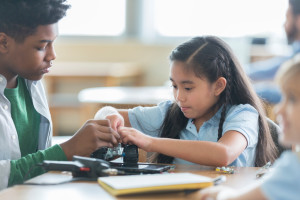
McREL’s focus on curiosity doesn’t preclude creativity—far from it! It’s just that we agree with Erik Shonstrom, in Wild Curiosity: How to Unleash Creativity and Encourage Lifelong Wondering, when he says that “to be creative one must first be curious. Being in an environment that fosters curiosity is vital to the creative process.” In other words, curiosity is the precursor to creativity.
Shonstrom says that curiosity allows us to enter what he calls “the flow state,” which happens when we become so positively and pleasurably focused on a task that we lose track of time and ignore everything else happening around us. Add the emotional satisfaction of flow to the intellectual satisfaction of curiosity, and you’ve got ideal conditions for creativity to flourish.
But, can flow be taught? Shonstrom admits to having doubts, but he thinks there’s plenty more that schools could be doing to stimulate creativity. “What seems crucial is to provide ourselves and our kids with the time, autonomy, and freedom to explore our curiosity enough to find that experience that resonates so deeply for us that we find our flow,” he says. Only then will we be on the path to creativity.
We’ve all heard and read stories of inspiration striking people like lightning, leading to a creative outpouring that leads to sudden success. But, in reality, that rarely happens. Curiosity needs to be nurtured and explored, and creativity requires dedicated work and experimentation. For example, before you can sing most anything, wrote Rodgers and Hammerstein in The Sound of Music, you must know the notes to sing. (And, I might point out, before R&H could use their creativity to write The Sound of Music, they first had to read and be inspired by Maria von Trapp’s autobiography, an act of learning that did not, itself, involve creativity, but rather curiosity.)
Educators aren’t shielded from the desire to see inspiration substitute for perspiration, to borrow an aphorism. This age-old tiff routinely gets played out in the recurring conflict between “whole child” and “back to basics” schooling. My version of curiosity leads me to ask: Why on Earth can’t we do both? Teach children the basics, teach them the habits of curiosity, and nudge them towards creativity via flow—sounds like a great plan to me.

